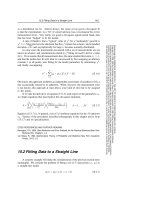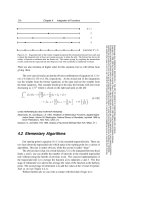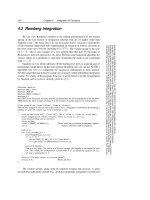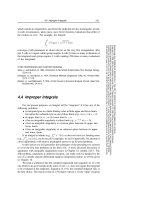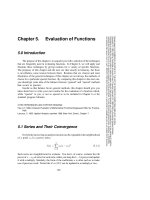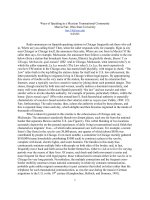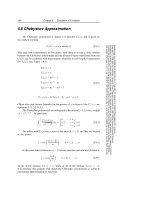Tài liệu OUTLINES OF DAIRY BACTERIOLOGY A CONCISE MANUAL FOR THE USE OF STUDENTS IN DAIRYING docx
Bạn đang xem bản rút gọn của tài liệu. Xem và tải ngay bản đầy đủ của tài liệu tại đây (752.75 KB, 201 trang )
OUTLINES
OF
DAIRY BACTERIOLOGY
A CONCISE MANUAL FOR THE USE OF STUDENTS IN DAIRYING
BY
H. L. RUSSELL
DEAN OF THE COLLEGE OF AGRICULTURE, UNIVERSITY OF WISCONSIN
EIGHTH EDITION
THOROUGHLY REVISED
MADISON, WISCONSIN
H. L. RUSSELL
1907
COPYRIGHTED 1905
BY
H. L. RUSSELL
STATE JOURNAL PRINTING COMPANY,
PRINTERS AND STEREOTYPERS,
MADISON, WIS.
Transcriber's note: Minor typos have been corrected.
PREFACE.
Knowledge in dairying, like all other technical industries, has grown mainly out of
experience. Many facts have been learned by observation, but the why of each is
frequently shrouded in mystery.
Modern dairying is attempting to build its more accurate knowledge upon a broader
and surer foundation, and in doing this is seeking to ascertain the cause of well-
established processes. In this, bacteriology is playing an important rôle. Indeed, it may
be safely predicted that future progress in dairying will, to a large extent, depend upon
bacteriological research. As Fleischmann, the eminent German dairy scientist, says:
"The gradual abolition of uncertainty surrounding dairy manufacture is the present
important duty which lies before us, and its solution can only be effected by
bacteriology."
It is therefore natural that the subject of Dairy Bacteriology has come to occupy an
important place in the curriculum of almost every Dairy School. An exposition of its
principles is now recognized as an integral part of dairy science, for modern dairy
practice is rapidly adopting the methods that have been developed as the result of
bacteriological study. The rapid development of the subject has necessitated a frequent
revision of this work, and it is gratifying to the writer that the attempt which has been
made to keep these Outlines abreast of bacteriological advance has been appreciated
by students of dairying.
While the text is prepared more especially for the practical[Pg iv] dairy operator who
wishes to understand the principles and reasons underlying his art, numerous
references to original investigations have been added to aid the dairy investigator who
wishes to work up the subject more thoroughly.
My acknowledgments are due to the following for the loan of illustrations: Wisconsin
Agricultural Experiment Station; Creamery Package Mfg. Co., Chicago, Ill.; and A. H.
Reid, Philadelphia, Pa.
H. L. RUSSELL.
UNIVERSITY OF WISCONSIN.
[Pg v]
CONTENTS.
CHAPTER I. Structure of the bacteria and conditions governing their development and
distribution 1
CHAPTER II. Methods of studying bacteria 13
CHAPTER III. Contamination of milk 19
CHAPTER IV. Fermentations in milk and their treatment 62
CHAPTER V. Relation of disease-bacteria to milk 82
Diseases transmissible from animal to man through diseased milk 84
Diseases transmissible to man through infection of milk after withdrawal 94
CHAPTER VI. Preservation of milk for commercial purposes 102
CHAPTER VII. Bacteria and butter making 134
Bacterial defects in butter 156
CHAPTER VIII. Bacteria in cheese 160
Influence Of bacteria in normal cheese processes 160
Influence of bacteria in abnormal cheese processes 182
[Pg 1]
CHAPTER I.
STRUCTURE OF THE BACTERIA AND CONDITIONS GOVERNING
THEIR DEVELOPMENT AND DISTRIBUTION.
Before one can gain any intelligent conception of the manner in which bacteria affect
dairying, it is first necessary to know something of the life history of these organisms
in general, how they live, move and react toward their environment.
Nature of Bacteria. Toadstools, smuts, rusts and mildews are known to even the
casual observer, because they are of evident size. Their plant-like nature can be more
readily understood from their general structure and habits of life. The bacteria,
however, are so small, that under ordinary conditions, they only become evident to our
unaided senses by the by-products of their activity.
When Leeuwenhoek (pronounced Lave-en-hake) in 1675 first discovered these tiny,
rapidly-moving organisms he thought they were animals. Indeed, under a microscope,
many of them bear a close resemblance to those minute worms found in vinegar that
are known as "vinegar-eels." The idea that they belonged to the animal kingdom
continued to hold ground until after the middle of the nineteenth century; but with the
improvement in microscopes, a more thorough study of these tiny structures was made
possible, and their vegetable nature demonstrated. The bacteria as a class are separated
from the fungi mainly by their method of growth; from the lower algae by the absence
of chlorophyll, the green coloring matter of vegetable organisms.[Pg 2]
Structure of bacteria. So far as structure is concerned the bacteria stand on the
lowest plane of vegetable life. The single individual is composed of but a single cell,
the structure of which does not differ essentially from that of many of the higher types
of plant life. It is composed of a protoplasmic body which is surrounded by a thin
membrane that separates it from neighboring cells that are alike in form and size.
Form and size. When a plant is composed of a single cell but little difference in form
is to be expected. While there are intermediate stages that grade insensibly into each
other, the bacteria may be grouped into three main types, so far as form is concerned.
These are spherical, elongated, and spiral, and to these different types are given the
names, respectively, coccus, bacillus and spirillum (plural, cocci, bacilli, spirilla) (fig.
1). A ball, a short rod, and a corkscrew serve as convenient models to illustrate these
different forms.
Fig. 1.
Different forms of bacteria. a, b, c, represent different types as to form: a, coccus, b,
bacillus, c, spirillum; d, diplococcus or twin coccus; e, staphylococcus or cluster
coccus; f and g, different forms of bacilli, g shows internal endospores within
cell; h and i, bacilli with motile organs (cilia).
In size, the bacteria are the smallest organisms that are known to exist. Relatively
there is considerable difference in[Pg 3]size between the different species, yet in
absolute amount this is so slight as to require the highest powers of the microscope to
detect it. As an average diameter, one thirty-thousandth of an inch may be taken. It is
difficult to comprehend such minute measurements, but if a hundred individual germs
could be placed side by side, their total thickness would not equal that of a single
sheet of paper upon which this page is printed.
Manner of Growth. As the cell increases in size as a result of growth, it elongates in
one direction, and finally a new cell wall is formed, dividing the so-called mother-cell
into two, equal-sized daughter-cells. This process of cell division, known as fission, is
continued until growth ceases and is especially characteristic of bacteria.
Cell Arrangement. If fission goes on in the same plane continually, it results in the
formation of a cell-row. A coccus forming such a chain of cells is called strepto-
coccus (chain-coccus). If only two cells cohere, it is called a diplo-coccus (twin-
coccus). If the second cell division plane is formed at right angles to the first, a cell
surface or tetrad is formed. If growth takes place in three dimensions of space, a cell
mass or sarcina is produced. Frequently, these cell aggregates cohere so tenaciously
that this arrangement is of value in distinguishing different species.
Spores. Some bacteria possess the property of forming spores within the mother cell
(called endospores, fig. 1g) that are analogous in function to the seeds of higher plants
and spores of fungi. By means of these structures which are endowed with greater
powers of resistance than the vegetating cell, the organism is able to protect itself
from the effect of an unfavorable environment. Many of the bacilli form endospores
but the cocci do not. It is these[Pg 4] spore forms that make it so difficult to
thoroughly sterilize milk.
Movement. Many bacteria are unable to move from place to place. They have,
however, a vibrating movement known as the Brownian motion that is purely
physical. Many other kinds are endowed with powers of locomotion. Motion is
produced by means of fine thread-like processes of protoplasm known
as cilia (sing. cilium) that are developed on the outer surface of the cell. By means of
the rapid vibration of these organs, the cell is propelled through the medium. Nearly
all cocci are immotile, while the bacilli may or may not be. These cilia are so delicate
that it requires special treatment to demonstrate their presence.
Classification. In classifying or arranging the different members of any group of
living objects, certain similarities and dissimilarities must be considered. These are
usually those that pertain to the structure and form, as such are regarded as most
constant. With the bacteria these differences are so slight that they alone do not suffice
to distinguish distinctly one species from another. As far as these characters can be
used, they are taken, but in addition, many characteristics of a physiological nature are
added. The way that the organism grows in different kinds of cultures, the by-products
produced in different media, and effect on the animal body when injected into the
same are also used as data in distinguishing one species from another.
Conditions favoring bacterial growth. The bacteria, in common with all other living
organisms are affected by external conditions, either favorably or unfavorably. Certain
conditions must prevail before development can occur. Thus, the organism must be
supplied with an adequate[Pg 5] and suitable food supply and with moisture. The
temperature must also range between certain limits, and finally, the oxygen
requirements of the organism must be considered.
Food supply. Most bacteria are capable of living on dead, inert, organic matter, such
as meats, milk and vegetable material, in which case, they are known as saprophytes.
In contradistinction to this class is a smaller group known asparasites, which derive
their nourishment from the living tissues of animals or plants. The first group
comprise by far the larger number of known organisms which are concerned for the
most part in the decomposition of organic matter. The parasitic group includes those
which are the cause of various communicable diseases. Between these two groups
there is no sharp line of division, and in some cases, certain species possess the faculty
of growing either as parasites or saprophytes, in which case they are known
as facultative parasites or saprophytes.
The great majority of bacteria of interest in dairying belong to the saprophytic class;
only those species capable of infecting milk through the development of disease in the
animal are parasites in the strict sense of the term. Most disease-producing species, as
diphtheria or typhoid fever, while parasitic in man lead a saprophytic method of life so
far as their relation to milk is concerned.
Bacteria require for their growth, nitrogen, hydrogen, carbon, oxygen, together with a
limited amount of mineral matter. The nitrogen and carbon are most available in the
form of organic compounds, such as albuminous material. Carbon in the form of
carbohydrates, as sugar or starch, is most readily attacked by bacteria.
Inasmuch as the bacteria are plant-cells, they must imbibe[Pg 6] their food from
material in solution. They are capable of living on solid substances, but in such cases,
the food elements must be rendered soluble, before they can be appropriated. If
nutritive liquids are too highly concentrated, as in the case of syrups and condensed
milk, bacteria cannot grow therein, although all the necessary ingredients may be
present. Generally, bacteria prefer a neutral or slightly alkaline medium, rather than
one of acid reaction; but there are numerous exceptions to this general rule, especially
among the bacteria found in milk.
Temperature. Growth of bacteria can only occur within certain temperature limits,
the extremes of which are designated as the minimum and maximum. Below and above
these respective limits, life may be retained in the cell for a time, but actual cell-
multiplication is stopped. Somewhere between these two cardinal temperature points,
and generally nearer the maximum limit is the most favorable temperature for growth,
known as the optimum. The temperature zone of most dairy bacteria in which growth
occurs ranges from 40°-45° F. to somewhat above blood-heat, 105°-110° F., the
optimum being from 80°-95° F. Many parasitic species, because of their adaptation to
the bodies of warm-blooded animals, generally have a narrower range, and a higher
optimum, usually approximating the blood heat (98°-99° F). The broader growth
limits of bacteria in comparison with other kinds of life explain why these organisms
are so widely distributed in nature.
Air supply. Most bacteria require as do the green plants and animal life, the free
oxygen of the air for their respiration. These are called aerobic. Some species,
however, and some yeasts as well possess the peculiar property of taking the oxygen
which they need from organic compounds[Pg 7] such as sugar, etc., and are therefore
able to live and grow under conditions where the atmospheric air is excluded. These
are known as anaerobic. While some species grow strictly under one condition or the
other, and hence are obligate aerobes or anaerobes, others possess the ability of
growing under either condition and are known as facultative or optional forms. The
great majority of milk bacteria are either obligate or facultative aerobes.
Rate of growth. The rate of bacterial development is naturally very much affected by
external conditions, food supply and temperature exerting the most influence. In the
neighborhood of the freezing point but little growth occurs. The rate increases with a
rise in temperature until at the optimum point, which is generally near the blood heat
or slightly below (90°-98° F.), a single cell will form two cells in 20 to 30 minutes. If
temperature rises much above blood heat rate of growth is lessened and finally ceases.
Under ideal conditions, rapidity of growth is astounding, but this initially rapid rate of
development cannot be maintained indefinitely, for growth is soon limited by the
accumulation of by-products of cell activity. Thus, milk sours rapidly at ordinary
temperatures until the accumulation of acid checks its development.
Detrimental effect of external conditions. Environmental influences of a detrimental
character are constantly at work on bacteria, tending to repress their development or
destroy them. These act much more readily on the vegetating cell than on the more
resistant spore. A thorough knowledge of the effect of these antagonistic forces is
essential, for it is often by their means that undesirable bacteria may be killed out.[Pg
8]
Effect of cold. While it is true that chilling largely prevents fermentative action, and
actual freezing stops all growth processes, still it does not follow that exposure to low
temperatures will effectually destroy the vitality of bacteria, even in the vegetative
condition. Numerous non-spore-bearing species remain alive in ice for a prolonged
period, and recent experiments with liquid air show that even a temperature of -310°
F. for hours does not effectually kill all exposed cells.
Effect of heat. High temperatures, on the other hand, will destroy any form of life,
whether in the vegetative or latent stage. The temperature at which the vitality of the
cell is lost is known as the thermal death point. This limit is not only dependent upon
the nature of the organism, but varies with the time of exposure and the condition in
which the heat is applied. In a moist atmosphere the penetrating power of heat is great;
consequently cell-death occurs at a lower temperature than in a dry atmosphere. An
increase in time of exposure lowers the temperature point at which death occurs.
For vegetating forms the thermal death point of most bacteria ranges from 130°-140°
F. where the exposure is made for ten minutes which is the standard arbitrarily
selected. In the spore stage resistance is greatly increased, some forms being able to
withstand steam at 210°-212° F. from one to three hours. If dry heat is employed,
260°-300° F. for an hour is necessary to kill spores. Where steam is confined under
pressure, a temperature of 230°-240° F. for 15-20 minutes suffices to kill all spores.
Drying. Spore-bearing bacteria like anthrax withstand drying with impunity; even
tuberculous material, although not possessing spores retains its infectious properties
for[Pg 9] many months. Most of the dairy bacteria do not produce spores, and yet in a
dry condition, they retain their vitality unimpaired for considerable periods, if they are
not subjected to other detrimental influences.
Light. Bright sunlight exerts on many species a powerful disinfecting action, a few
hours being sufficient to destroy all cells that are reached by the sun's rays. Even
diffused light has a similar effect, although naturally less marked. The active rays in
this disinfecting action are those of the chemical or violet end of the spectrum, and not
the heat or red rays.
Influence of chemical substances. A great many chemical substances exert a more or
less powerful toxic action of various kinds of life. Many of these are of great service
in destroying or holding bacterial growth in check. Those that are toxic and result in
the death of the cell are known as disinfectants; those that merely inhibit, or retard
growth are known as antiseptics. All disinfectants must of necessity be antiseptic in
their action, but not all antiseptics are disinfectants even when used in strong doses.
Disinfectants have no place in dairy work, except to destroy disease bacteria, or
preserve milk for analytical purposes. Corrosive sublimate or potassium bichromate
are most frequently used for these purposes. The so-called chemical preservatives
used to "keep" milk depend for their effect on the inhibition of bacterial growth. With
a substance so violently toxic as formaldehyde (known as formalin, freezene)
antiseptic doses are likely to be exceeded. In this country most states prohibit the use
of these substances in milk. Their only function in the dairy should be to check
fermentative or putrefactive processes outside of milk and so keep the air free from
taints.[Pg 10]
Products of growth. All bacteria in their development form certain more or less
characteristic by-products. With most dairy bacteria, these products are formed from
the decomposition of the medium in which the bacteria may happen to live. Such
changes are known, collectively, as fermentations, and are characterised by the
production of a large amount of by-products, as a result of the development of a
relatively small amount of cell-life. The souring of milk, the formation of butyric acid,
the making of vinegar from cider, are all examples of fermentative changes.
With many bacteria, especially those that affect proteid matter, foul-smelling gases are
formed. These are known as putrefactive changes. All organic matter, under the action
of various organisms, sooner or later undergoes decay, and in different stages of these
processes, acids, alkalies, gases and numerous other products are formed. Many of
these changes in organic matter occur only when such material is brought in direct
contact with the living bacterial cell.
In other instances, soluble, non-vital ferments known as enzyms are produced by the
living cell, which are able to act on organic matter, in a medium free from live cells,
or under conditions where the activity of the cell is wholly suspended. These enzyms
are not confined to bacteria but are found throughout the animal and plant world,
especially in those processes that are concerned in digestion. Among the better known
of these non-vital ferments are rennet, the milk-curdling enzym; diastase or ptyalin of
the saliva, the starch-converting enzym; pepsin and trypsin, the digestive ferments of
the animal body.
Enzyms of these types are frequently found among the bacteria and yeasts and it is by
virtue of this characteristic[Pg 11] that these organisms are able to break down such
enormous quantities of organic matter. Most of these enzyms react toward heat, cold
and chemical poisons in a manner quite similar to the living cells. In one respect they
are readily differentiated, and that is, that practically all of them are capable of
producing their characteristic chemical transformations under anaesthetic conditions,
as in a saturated ether or chloroform atmosphere.
Distribution of bacteria. As bacteria possess greater powers of resistance than most
other forms of life, they are to be found more widely distributed than any other type.
At the surface of the earth, where conditions permit of their growth, they are found
everywhere, except in the healthy tissues of animals and plants. In the superficial soil
layers, they exist in myriads, as here they have abundance of nourishment. At the
depth of several feet however, they diminish rapidly in numbers, and in the deeper soil
layers, from six to ten feet or more, they are not present, because of the unsuitable
growth conditions.
The bacteria are found in the air because of their development in the soil below. They
are unable to grow even in a moist atmosphere, but are so readily dislodged by wind
currents that over land areas the lower strata of the air always contain them. They are
more numerous in summer than in winter; city air contains larger numbers than
country air. Wherever dried fecal matter is present, as in barns, the air contains many
forms.
Water contains generally enough organic matter in solution, so that certain types of
bacterial life find favorable growth conditions. Water in contact with the soil surface
takes up many impurities, and is of necessity rich in microbes. As the rain water
percolates into the soil, it loses[Pg 12] its germ content, so that the normal ground
water, like the deeper soil layers, contains practically no bacterial life. Springs
therefore are relatively deficient in germ life, except as they become infected with soil
organisms, as the water issues from the soil. Water may serve to disseminate certain
infectious diseases as typhoid fever and cholera among human beings, and a number
of animal maladies.
While the inner tissues of healthy animals are free from bacteria, the natural passages
as the respiratory and digestive tracts, being in more direct contact with the exterior,
become more readily infected. This is particularly true with reference to the intestinal
tract, for in the undigested residue, bacterial activity is at a maximum. The result is
that fecal matter contains enormous numbers of organisms so that the possibility of
pollution of any food medium such as milk with such material is sure to introduce
elements that seriously affect the quality of the product.
[Pg 13]
CHAPTER II.
METHODS OF STUDYING BACTERIA.
Necessity of bacterial masses for study. The bacteria are so extremely small that it is
impossible to study individual germs separately without the aid of first-class
microscopes. For this reason, but little advance was made in the knowledge of these
lower forms of plant life, until the introduction of culture methods, whereby a single
organism could be cultivated and the progeny of this cell increased to such an extent
in a short course of time, that they would be visible to the unaided eye.
This is done by growing the bacteria in masses on various kinds of food media that are
prepared for the purpose, but inasmuch as bacteria are so universally distributed, it
becomes an impossibility to cultivate any special form, unless the medium in which
they are grown is first freed from all pre-existing forms of germ life. To accomplish
this, it is necessary to subject the nutrient medium to some method of sterilization,
such as heat or filtration, whereby all life is completely destroyed or eliminated. Such
material after it has been rendered germ-free is kept in sterilized glass tubes and
flasks, and is protected from infection by cotton stoppers.
Culture media. For culture media, many different substances are employed. In fact,
bacteria will grow on almost any organic substance whether it is solid or fluid,
provided the other essential conditions of growth are furnished. The food substances
that are used for culture purposes are divided into two classes; solids and liquids.[Pg
14]
Solid media may be either permanently solid like potatoes, or they may retain their
solid properties only at certain temperatures like gelatin or agar. The latter two are of
utmost importance in bacteriological research, for their use, which was introduced by
Koch, permits the separation of the different forms that may happen to be in any
mixture. Gelatin is used advantageously because the majority of bacteria present wider
differences due to growth upon this medium than upon any other. It remains solid at
ordinary temperatures, becoming liquid at about 70° F. Agar, a gelatinous product
derived from a Japanese sea-weed, has a much higher melting point, and can be
successfully used, especially with those organisms whose optimum growth point is
above the melting point of gelatin.
Besides these solid media, different liquid substances are extensively used, such as
beef broth, milk, and infusions of various vegetable and animal tissues. Skim-milk is
of especial value in studying the milk bacteria and may be used in its natural
condition, or a few drops of litmus solution may be added in order to detect any
change in its chemical reaction due to the bacteria.
Fig. 2. A gelatin plate culture
showing appearance of different organisms in a sample of milk. Each mass
represents a bacterial growth (colony) derived from a single cell. Different forms
react differently toward the gelatin, some liquefying the same, others growing in
a restricted mass. a, represents a colony of the ordinary bread mold; b, a
liquefying bacterium; c, and d, solid forms.
Methods of isolation. Suppose for instance one wishes to isolate the different
varieties of bacteria found in milk. The method of procedure is as follows: Sterile
gelatin in glass tubes is melted and cooled down so as to be barely warm. To this
gelatin which is germ-free a drop of milk is added. The gelatin is then gently shaken
so as to thoroughly distribute the milk particles, and poured out into a sterile flat glass
dish and quickly covered. This is allowed to stand on a cool surface until the gelatin
hardens. After the culture plate has been left for twenty-four to thirty-six[Pg 15] hours
at the proper temperature, tiny spots will begin to appear on the surface, or in the
depth of the culture medium. These patches are called colonies and are composed of
an almost infinite number of individual germs, the result of the continued growth of a
single organism that was in the drop of milk which was firmly held in place when the
gelatin solidified. The number of these colonies represents approximately the number
of germs that were present in the milk drop. If the plate is not too thickly sown with
these germs, the colonies will continue to grow and increase in size, and as they do,
minute differences will begin to appear. These differences may be in the color, the
contour and the texture of the colony, or[Pg 16] the manner in which it acts toward
gelatin. In order to make sure that the seeding in not too copious so as to interfere with
continued study, an attenuation is usually made. This consists in taking a drop of the
infected gelatin in the first tube, and transferring it to another tube of sterile media.
Usually this operation is repeated again so that these culture plates are made with
different amounts of seed with the expectation that in at least one plate the seeding
will not be so thick as to prevent further study. For transferring the culture a loop
made of platinum wire is used. By passing this through a gas flame, it can be
sufficiently sterilized.
Fig. 3.
Profile view of gelatin plate culture; b, a liquefying form that dissolves the
gelatin; c and d, surface colonies that do not liquefy the gelatin.
To further study the peculiarities of different germs, the separate colonies are
transferred to other sterile tubes of culture material and thus pure cultures of the
various germs are secured. These cultures then serve as a basis for continued study
and must be planted and grown upon all the different kinds of media that are
obtainable. In this way the slight variations in the growth of different forms are
detected and the peculiar characteristics are determined, so that the student is able to
recognize this form when he meets it again.
These culture methods are of essential importance in bacteriology, as it is the only
way in which it is possible to secure a quantity of germs of the same kind.[Pg 17]
The microscope in bacterial investigation. In order to verify the purity of the
cultures, the microscope is in constant demand throughout all the different stages of
the isolating process. For this purpose, it is essential that the instrument used shall be
one of strong magnifying powers (600-800 diameters), combined with sharp
definition.
Fig. 4.
Pure cultures of different kinds of bacteria in gelatin tubes. a, growth slight in this
medium; b, growth copious at and near surface. Fine parallel filaments growing out
into medium liquefying at surface; c, a rapid liquefying form; d, a gas-producing form
that grows equally well in lower part of tube as at surface (facultative anaerobe); e, an
obligate anaerobe, that develops only in absence of air.
The microscopical examination of any germ is quite as[Pg 18] essential as the
determination of culture characteristics; in fact, the two must go hand in hand. The
examination reveals not only the form and size of the individual germs, but the
manner in which they are united with each other, as well as any peculiarities of
movement that they may possess.
In carrying out the microscopical part of the work, not only is the organism examined
in a living condition, but preparations are made by using solutions of anilin dyes as
staining agents. These are of great service in bringing out almost imperceptible
differences. The art of staining has been carried to the highest degree of perfection in
bacteriology, especially in the detection of germs that are found in diseased tissues in
the animal or human body.
In studying the peculiarities of any special organism, not only is it necessary that these
cultural and microscopical characters should be closely observed, but special
experiments must be carried out along different lines, in order to determine any
special properties that the germ may possess. Thus, the ability of any form to act as a
fermentative organism can be tested by fermentation experiments; the property of
causing disease, studied by the inoculation of pure cultures into animals. A great many
different methods have been devised for the purpose of studying special
characteristics of different bacteria, but a full description of these would necessarily
be so lengthy that in a work of this character they must be omitted. For details of this
nature consult standard reference books on bacteriological technique.
[Pg 19]
CHAPTER III.
CONTAMINATION OF MILK.
No more important lesson is to be learned than that which relates to the ways in which
milk is contaminated with germ life of various kinds; for if these sources of infection
are thoroughly recognized they can in large measure be prevented, and so the troubles
which they engender overcome. Various organisms find in milk a congenial field for
development. Yeasts and some fungi are capable of growth, but more particularly the
bacteria.
Milk a suitable bacterial food. The readiness with which milk undergoes
fermentative changes indicates that it is well adapted to nourish bacterial life. Not only
does it contain all the necessary nutritive substances but they are diluted in proper
proportions so as to render them available for bacterial as well as mammalian life.
Of the nitrogenous compounds, the albumen is in readily assimilable form. The
casein, being insoluble, is not directly available, until it is acted upon by proteid-
dissolving enzyms like trypsin which may be secreted by bacteria. The fat is relatively
resistant to change, although a few forms are capable of decomposing it. Milk sugar,
however, is an admirable food for many species, acids and sometimes gases being
generally produced.
Condition when secreted. When examined under normal conditions milk always
reveals bacterial life, yet in the secreting cells of the udder of a healthy cow germ life
is not found. Only when the gland is diseased are bacteria[Pg 20]found in any
abundance. In the passage of the milk from the secreting cells to the outside it receives
its first infection, so that when drawn from the animal it generally contains a
considerable number of organisms.
Fig. 5. Microscopic appearance of
milk showing relative size of fat globules and bacteria.
Contamination of milk. From this time until it is consumed in one form or another, it
is continually subjected to contamination. The major part of this infection occurs
while the milk is on the farm and the degree of care which is exercised while the
product is in the hands of the milk producer is the determining factor in the course of
bacterial changes involved. This of course does not exclude the possibility of
contamination in the factory, but usually milk is so thoroughly seeded by the time it
reaches the factory that the infection which occurs here plays a relatively minor rôle to
that which happens earlier. The great majority of the organisms in milk are in no wise
dangerous to health, but many species are capable of producing various fermentative
changes that injure the quality of the product for butter or cheese. To be able to
control abnormal changes of an undesirable character one must know the sources of
infection which permit of the introduction of these unwelcome intruders.[Pg 21]
Sources of infection. The bacterial life that finds its way into milk while it is yet on
the farm may be traced to several sources, which may be grouped under the following
heads: unclean dairy utensils, fore milk, coat of animal, and general atmospheric
surroundings. The relative importance of these various factors fluctuates in each
individual instance.
Dairy utensils. Of first importance are the vessels that are used during milking, and
also all storage cans and other dairy utensils that come in contact with the milk after it
is drawn. By unclean utensils, actually visible dirt need not always be considered,
although such material is often present in cracks and angles of pails and cans. Unless
cleansed with especial care, these are apt to be filled with foul and decomposing
material that suffices to seed thoroughly the milk. Tin utensils are best. Where made
with joints, they should be well flushed with solder so as to be easily cleaned (see Fig.
6). In much of the cheaper tin ware on the market, the soldering of joints and seams is
very imperfect, affording a place of refuge for bacteria and dirt.
Cans are often used when they are in a condition wholly unsuitable for sanitary
handling of milk. When the tin coating becomes broken and the can is rusty, the
quality of the milk is often profoundly affected. Olson
[1]
of the Wisconsin Station has
shown that the action of rennet is greatly impaired where milk comes in contact with a
rusty iron surface.
Fig. 6.
With the introduction of the form or hand separator a new milk utensil has been added
to those previously in use and one which is very frequently not well cleaned.
Where[Pg 22] water is run through the machine to rinse out the milk particles, gross
bacterial contamination occurs and the use of the machine much increases the germ
content of the milk. Every time the separator is used it should be taken apart and
thoroughly cleaned and dried before reassembling.
[2]
Use of milk-cans for transporting factory by-products. The general custom of
using the milk-cans to carry back to the farm the factory by-products (skim-milk or
whey) has much in it that is to be deprecated. These by-products are generally rich in
bacterial life, more especially where the closest scrutiny is not given to the daily
cleaning of the vats and tanks. Too frequently the cans are not cleaned immediately
upon arrival at the farm, so that the conditions are favorable for rapid fermentation.
Many of the taints that bother factories are directly traceable to such a cause. A few
dirty patrons will thus seriously infect the whole supply. The responsibility for this
defect should, however, not be laid entirely upon the shoulders of the producer. The
factory operator should see that the refuse material does not accumulate in the waste
vats from day to day and is not transformed into a more or less putrid mass. A dirty
whey tank is not an especially good object lesson to the patron to keep his cans clean.
It is possible that abnormal fermentations or even contagious diseases may thus be
disseminated.
Suppose there appears in a dairy an infectious milk trouble, such as bitter milk. This
milk is taken to the factory and passes unnoticed into the general milk-supply. The
skim-milk from the separator is of course infected with the germ, and if conditions
favor its growth, the whole lot soon becomes tainted. If this waste product is returned
to the different patrons in the same cans that are used for the fresh milk, the
probabilities are strongly in[Pg 23] favor of some of the cans being contaminated and
thus infecting the milk supply of the patrons. If the organism is endowed with spores
so that it can withstand unfavorable conditions, this taint may be spread from patron to
patron simply through the infection of the vessels that are used in the transportation of
the by-products. Connell has reported just such a case in a Canadian cheese factory
where an outbreak of slimy milk was traced to infected whey vats. Typhoid fever
among people, foot and mouth disease and tuberculosis among stock are not
infrequently spread in this way. In Denmark, portions of Germany and some states in
America, compulsory heating of factory by-products is practiced to eliminate this
danger.
[3]
Pollution of cans from whey tanks. The danger is greater in cheese factories than in
creameries, for whey usually represents a more advanced stage of fermentation than
skim-milk. The higher temperature at which it is drawn facilitates more rapid bacterial
growth, and the conditions under which it is stored in many factories contribute to the
ease with which fermentative changes can go on in it. Often this by-product is stored
in wooden cisterns or tanks, situated below ground, where it becomes impossible to
clean them out thoroughly. A custom that is almost universally followed in the Swiss
cheese factories, here in this country, as in Switzerland, is fully as reprehensible as
any[Pg 24] dairy custom could well be. In Fig. 7 the arrangement in vogue for the
disposal of the whey is shown. The hot whey is run out through the trough from the
factory into the large trough that is placed over the row of barrels, as seen in the
foreground. Each patron thus has allotted to him in his individual barrel his portion of
the whey, which he is supposed to remove day by day. No attempt is made to clean
out these receptacles, and the inevitable result is that they become filled with a foul,
malodorous liquid, especially in summer. When such material is taken home in the
same set of cans that is used to bring the fresh milk (twice a day as is the usual custom
in Swiss factories), it is no wonder that this industry is seriously handicapped by
"gassy" fermentations that injure materially the quality of the product. Not only is the
above danger a very[Pg 25] considerable one, but the quality of the factory by-product
for feeding purposes, whether it is skim-milk or whey, is impaired through the
development of fermentative changes.
Fig. 7.
Swiss cheese factory (Wisconsin), showing careless way in which whey is handled.
Each patron's share is placed in a barrel, from which it is removed by him. No attempt
is made to cleanse these receptacles.
Improved methods of disposal of by-products. The difficulties which attend the
distribution of these factory by-products have led to different methods of solution.
One is to use another separate set of receptacles to carry back these products to the
farm. This method has been tried, and while it is deemed impracticable by many to
handle two sets of vessels, yet some of the most progressive factories report excellent
results where this method is in use.
Large barrels could be used for this purpose to economize in wagon space.
Another method that has met with wider acceptance, especially in creameries, is the
custom of pasteurizing or scalding the skim-milk immediately after it is separated, so
that it is returned to the farmer in a hot condition. In factories where the whole milk is
pasteurized, further treatment of the by-product is not necessary. In most factories
steam, generally exhaust, is used directly in the milk, and experience has shown that
such milk, without any cooling, will keep sweet for a considerable number of hours
longer than the untreated product. It is noteworthy that the most advanced and
progressive factories are the ones that appreciate the value of this work, and although
it involves some time and expense, experience has shown the utility of the process in
that a better grade of milk is furnished by the patrons of factories which follow this
practice.
[4]
The exclusion of all danger of animal or human disease is also possible in
this way.
[Pg 26]
Cleaning dairy utensils. The thorough cleaning of all dairy apparatus that in any way
comes in contact with the milk is one of the most fundamental and important problems
in dairying. All such apparatus should be so constructed as to permit of easy cleaning.
Tinware, preferably of the pressed variety, gives the best surface for this purpose and
is best suited for the handling of milk.
Milk vessels should never be allowed to become dry when dirty, for dried particles of
milk residue are extremely difficult to remove. In cleaning dairy utensils they should
first be rinsed in lukewarm instead of hot water, so as to remove organic matter
without coagulating the milk. Then wash thoroughly in hot water, using a good
washing powder. The best washing powders possess considerable disinfecting
action.
[5]
Strong alkalies should not be used. After washing rinse thoroughly in clean
hot water. If steam is available, as it always is in creameries, cans and pails should be
turned over jet for a few moments. While a momentary exposure will not suffice to
completely sterilize such a vessel, yet many bacteria are killed in even a short
exposure, and the cans dry more thoroughly and quickly when heated by steam.
Not only should the greatest care be paid to the condition of the cans and milk-pails,
but all dippers, strainers, and other utensils that come in contact with the milk must be
kept equally clean. Cloth strainers, unless attended to, are objectionable, for the fine
mesh of the cloth retains so much moisture that they become a veritable hot-bed of
bacterial life, unless they are daily boiled or steamed.
The inability to thoroughly render vessels bacteria-free with the conveniences which
are generally to be found on the farm has led in some cases to the custom of washing
and sterilizing the milk cans at the factory.
[Pg 27]
Germ content of milk utensils. Naturally the number of bacteria found in different
milk utensils after they have received their regular cleaning will be subject to great
fluctuations; but, nevertheless, such determinations are of value as giving a scientific
foundation for practical methods of improvement. The following studies may serve to
indicate the relative importance of the utensils as a factor in milk contamination.
Two cans were taken, one of which had been cleaned in the ordinary way, while the
other was sterilized by steaming. Before milking, the udder was thoroughly cleaned
and special precautions taken to avoid raising of dust; the fore milk was rejected. Milk
drawn into these two cans showed the following germ content:
No. bacteria per cc.
Hours before souring.
Steamed pail
165 28-1/2
Ordinary pail
426 523
Harrison
[6]
has shown how great a variation is in the bacterial content in milk cans.
The utensils were rinsed with 100 cc. of sterile water and numerical determinations of
this rinsing water made. In poorly cleaned cans, the average germ content was
442,000; in cans washed in tepid water and then scalded—the best farm practice—
54,000, and in cans carefully washed and then steamed for five minutes, 880.
Another method used by the writer is to wash the utensil with 100 cc. sterile wash
water, using a sterile swab to remove dirt. Then repeat the process twice or more with
fresh rinsing waters, making plate cultures from each. The following data were
obtained from three such determinations:[Pg 28]
No. bacteria in different washings.
I. II. III. Total No. bacteria.
7,800,000
1,450,000
49,000
9,299,000
283,000 43,400 35,000
361,400
1,685,000
105,000 61,400
1,851,400
Infection of milk in udder cavity. A frequently neglected but considerable factor of
infection is that which is attributable to the bacteria which are present in the udder and
which are removed in large numbers during the milking process. An examination of
the fore milk, i. e., the first few streams from each teat, and that which is subsequently
withdrawn, generally reveals a very much larger number of organisms in the fore
milk.
[7]
Not infrequently will this part of the milk when drawn under as careful
conditions as possible, contain several score thousand organisms per cc. If successive
bacterial determinations are made at different periods of the milking, as shown in the
following experiment, a marked diminution is to be noted after the first portion of the
milk is removed:

